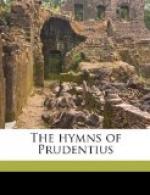1 This poem has given four hymns to the Roman
Breviary:—
(1) For the Feast of
the Transfiguration, Vespers and Matins
consisting of ll. 1-4,
37-40, 41-44, 85-88.
(2) For the Epiphany
at Lauds, beginning O sola magnarum urbium,
ll. 77-80, 5-8, 61-72.
(3) For the Feast of
Holy Innocents at Matins, beginning Audit
tyrannus anxius,
ll. 93-100, 133-136.
(4) Also the Feast of
Holy Innocents at Lauds, beginning Salvete
flores martyrum,
ll. 125-132.
5 For a curious parallel to these opening lines
see Henry Vaughan’s
Pious Thoughts and
Ejaculations (the Nativity):—
“But
stay! what light is that doth stream
And
drop here in a gilded beam?
It
is Thy star runs Page and brings
Thy
tributary Eastern kings.
Lord!
grant some light to us that we
May
find with them the way to Thee!”
12 Cf. Ignatius, Ep. ad Ephes. xix.:
“All the other stars, together
with the Sun and Moon,
became a chorus to the Star, which in its
light excelled them
all.”
15 Prudentius mentions the constellations of Ursa
Major and Ursa
Minor (to which latter
the Pole Star belongs) as examples of stars
in constant apparition.
All the Little Bear stars are within about
24 deg. from the Pole;
hence, if viewed from Saragossa, the birthplace
of Prudentius, the lowest
altitude of any of them would be 18 deg.
above the north horizon.
The same applies to the majority of the
stars in the Great Bear.
Some few would sink below the horizon
for a brief time in
each twenty-four hours; but the greater number,
especially the seven
principal stars known as the “Plough,”
would
be sufficiently high
up at their lowest northern altitudes to be in
perpetual apparition.
[My friend, Rev. R. Killip, F.R.A.S., has
kindly furnished me
with these particulars.] Allusions to the Bears
are constantly recurring
in the classical poets (cf. e.g. Ovid.,
Met. xiii. 293,
immunemque aequoris Arcton, “the Bear
that never
touches the sea").
The idea that these stars are mostly hidden by
clouds, though perpetually
in view, is a poetic hyperbole intended
to enhance the uniqueness
of the Star of Bethlehem.
49 Jerome (ad Eustoch. Ep. 22) commenting
on the passage in Isa.
xi. 1, “And there
shall come forth a rod out of the root of Jesse,
and a flower shall rise
up out of his root” (Vulg.), remarks: “The
rod (virga) is
the mother of the Lord, simple, pure, sincere ...
the flower of the rod
is Christ, who saith, ’I am the flower of the
field and the lily of
the valleys.’”




